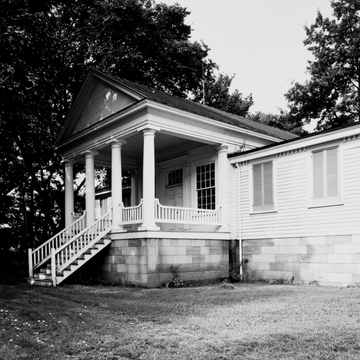You are here
Craik-Patton House (Elm Grove)
This raised frame cottage, one of Charleston's most distinguished early houses, is far larger than it appears. Standing high on a cut sandstone foundation, it is fronted by a handsome four-column Tuscan portico with a full entablature and pediment. One of the earliest houses in the Kanawha Valley to display such architectural refinement, it brought a glimpse of emerging classicism at a time when log and stone construction were still the norm.
James Craik, a lawyer who later became rector of St. John's Episcopal Church, built the house on Virginia Street. George S. Patton I, a Confederate colonel and grandfather of General Patton of World War II fame, bought it in 1858. The house was first moved in 1906, when a new street was cut through its site. When it was again threatened in the 1960s, the National Society of Colonial Dames of America in West Virginia spearheaded a drive to save the house. With support from the U.S. Department of Housing and Urban Development, it was relocated to its present riverbank setting east of Charleston, on a site provided by the State Department of Highways in 1973. The Colonial Dames have subsequently restored and furnished it to reflect the period of original construction.
Writing Credits
If SAH Archipedia has been useful to you, please consider supporting it.
SAH Archipedia tells the story of the United States through its buildings, landscapes, and cities. This freely available resource empowers the public with authoritative knowledge that deepens their understanding and appreciation of the built environment. But the Society of Architectural Historians, which created SAH Archipedia with University of Virginia Press, needs your support to maintain the high-caliber research, writing, photography, cartography, editing, design, and programming that make SAH Archipedia a trusted online resource available to all who value the history of place, heritage tourism, and learning.

